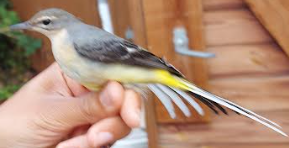Gedser Fuglestation Blog
Her på Gedser Fuglestations blog bringes korte nyheder i dagbogsformat om hændelser på fuglestationen.
Lots of wind from the west
The ringing:
The morning started windy and this continued for the rest of the day, but in the garden it was mostly sheltered so we could still open most nets. But there was not much to do for us, just twelve new birds in the nets, one nice species that is not caught that often was a juvenile Grey Wagtail “Bjergvipstjert”. But that gave us time for the moth between the rounds which was also nice, although more birds would be appreciated.

Grey Wagtail "Bjergvipstjert"
The moths:
Not many more moth species than birds in the traps, but there was not so much to expect as it was a quite windy night. But some nice ones and both Robert and I had new species.

Helicoverpa armigera "Kriger Træk Ugle"

Ennomos autumnaria "Stor Tandmåler"

Athetis lepigone

Migration Counts at Gedser Odde
Lara W
First, a quick apology for not updating the blog yesterday. Migration counts were minimal due to low visibility caused by heavy rain. Approximately 300 birds were spotted, most of which appeared in the final 40 minutes of standard time as the rain thankfully eased up. Several larger flocks of Common scoter/Sortand, interspersed with a few Sandwich tern/Splitterne (Thalasseus sandvicensis), and Wigeon/Pibeand (Anas Penelope), were seen far out on the horizon. Higher numbers of Mute Swan/Knopsvane (Cygnus olor), were counted than for the past week, totalling 83 individuals.
On to today’s count…
Seabird migration was surprisingly low, considering the relatively clear skies and lack of precipitation. Only 4 male Eider/Ederfugl (Somateria mollissima) were seen, all in eclipse plumage. In case the reader is unaware, the eclipse plumage is for cryptic purposes, making them less visible to predators during the period where the birds are in moult. Eiders, like several duck species, undergo full wing moult after breeding, replacing all their flight feathers at once which renders them essentially flightless until the feathers regrow. These darker “eclipse” feathers later abrade (wear down) into the signature white the species is known for.
Raptor numbers, on the other hand, were high, with 9 Honey Buzzard/Hvepsevåge (Pernis apivorus), 115 Sparrowhawk/Spurvehøg (Accipiter nisus), 7 Marsh Harrier/Rørhøg (Circus aeruginosus), 2 Merlin/Dværgfalk (Falco columbarius), and 3 Kestrel/Tårnfalk (Falco tinnunculus), counted flying out over the cliffs. At times it was difficult to know where to look, and at one point I was so focused on the Honey Buzzard overhead I almost missed the Sparrowhawk that passed within a metre of my face! Two birds not migrating, but which appeared over the fields to the north, deserve mention – a stunning Red Kite/Rød Glente (Milvus milvus), bedecked in a suit of russet and gold, and a juvenile White-tailed eagle/Havørn (Haliaeetus albicilla). The eagle made his sedate way across the fields and up above the station before moving away towards Gedser town, seemingly unphased by the small flock of Hooded Crow/Gråkrage (Corvus cornix) who attempted to mob him.
Five hours of birding wasn’t enough, so Gert and I went for a wander up to the nature reserve at Bøtø Nor. This was my first visit here, and we went to a couple of the hides (dubbed Fugletårn (“bird tower”) in Danish, I have to say this is a far better name for them than the rather boring name of “hide” in English!). The site comprises some 200 acres, and the Fugletårn look out onto a lake bordered by tall rushes and grassland, with a small wood to the south. A number of different duck and wader species were present, including Shoveler/Skeand (Anas clypeata), Gadwall/Knarand (Anas strepera), and Teal/Krikand (Anas crecca). A large mixed-age flock of Lapwing/Vibe (Vanellus vanellus) dominated the water, with several energetic Ruff/Brushane (Calidris pugnax) quick-stepping through the heftier birds in their search for small crustaceans, fish and molluscs within the mud below the water. One particular individual seemed a little more intrepid than the others, having waded in so the water level was at chest height, and therefore having to take some rather more violent steps to move effectively.
This peaceful but busy scene was periodically interrupted by the appearance of a juvenile White-tailed eagle, when all the waterbirds would erupt upwards, swirling and vortexing in the sky until this large predator had once more soared away on lazy wingbeats. A kestrel also provided me distraction, perching atop a small log in the grasslands in the sun for a little while. At one point, she must have spotted an insect, and with great intent, giving a distinct “hunting cat” impression, she scrambled after it, her high-stepping long legs giving a rather comical attitude to the endeavour.
At the final Fugletårn, two adult and one juvenile Crane/Trane (Grus grus) were seen grazing in the tall grasses, with several Great white egret/Sølvhejre (Ardea alba) and Grey Heron/Fiskehejre (Ardea cinerea) nearby. We arrived just in time to see them – after only a few minutes they flew off to join 4 other cranes who circled above the area for a while before disappearing south. Overall, a wonderful birding experience!
Robert Luttik, Lara Winsloe, Hanelie Sidhu



